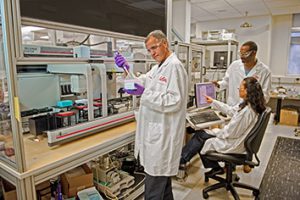
Lilly eliminating 3,500 jobs as part of cost-cutting plan
Indianapolis-based pharmaceutical giant Eli Lilly and Co. said the 3,500 jobs represent 8.3 percent of its global workforce. Lilly hopes the cuts will save it $500 million a year.

Indianapolis-based pharmaceutical giant Eli Lilly and Co. said the 3,500 jobs represent 8.3 percent of its global workforce. Lilly hopes the cuts will save it $500 million a year.

A virtual-power purchase agreement is a new type of energy contract that allows a large customer to support green-energy projects and hedge electricity prices

David Broecker was founding CEO of the four-year-old Indiana Biosciences Research Institute, which aims to bridge the gap between research universities and industry in life sciences.

The Indianapolis drugmaker said it will not be required to conduct another expensive, time-consuming clinical trial for the potential blockbuster.
Advanced imaging is a profit center at many hospitals, so the new policy will likely impose a hit on their bottom lines.
The program is hailed by health providers for allowing doctors, hospitals and pharmacies to check patients’ electronic health records for substance abuse.

Over the past 20 years, while the price of a gallon of milk climbed 23 percent and the sticker on a Dodge Caravan minivan rose 21 percent, the list price of the insulin Humalog shot up 1,157 percent.
Workers who lose their jobs will be eligible for federal assistance in training and education, the Labor Department has ruled.

In response to an employee survey two years ago that revealed shockingly low morale, IU Health executives respond with 33 town hall meetings over four months.
The design features plenty of glass and natural light, along with Indiana limestone and brick highlights. The facility, scheduled to open in 2020, will replace an aging hospital about five miles away.

Whether so-called micro-hospitals can succeed financially might depend on whether they can meet Medicare’s definition of a hospital: a medical facility that dedicates the bulk of its services to inpatient care.
The federal government says readmissions are often unnecessary and cost taxpayers tens of millions of dollars a year.

Starting Oct. 1, Anthem said, it could deny claims for hundreds of non-emergency diagnosis codes, such as bruises, rashes, minor burns, swimmer’s ear and athlete’s foot.
The transitional care hospital, which has lost money in two of the past three years, will reopen next year as Community Rehabilitation Hospital South.
The move could give Community a huge new stream of business. Thousands of people visit Walgreens stores in the Indianapolis area on a regular basis and about 40 percent of them don’t have primary care doctors.
Without dozens of insurance claims to file and follow up, physicians cut administrative overhead, reduce costs and keep their practices limited to a few hundred patients, rather than a few thousand.
The Indianapolis-based drugmaker warned that a much-anticipated new drug for rheumatoid arthritis might be delayed another 18 months.
Indiana Gov. Eric Holcomb says the law is “crumbling under its own weight” and that people in as many as 60 Indiana counties will be left with just one choice for insurance coverage on the marketplace next year.
The small hospitals serve residents who would otherwise be a long distance from emergency care.
The deal is Eli Lilly and Co.’s latest push into a growing disease area for such disorders as arthritis, lupus and multiple sclerosis.